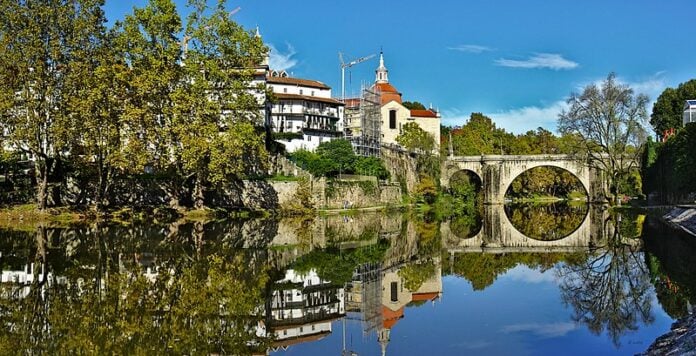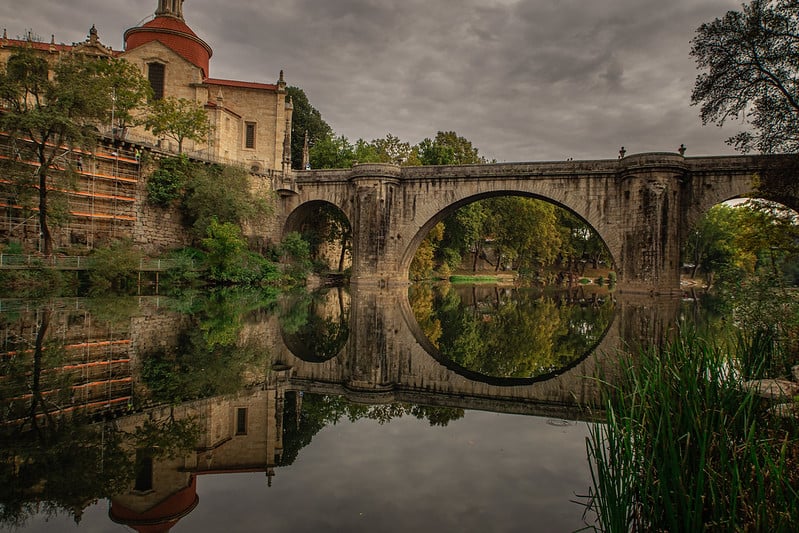Amarante, located in the Tâmega e Sousa region of northern Portugal and set against the Serra de Marvão, is a town rich in history and culture. Known for its picturesque setting, it sits on the banks of the Tâmega River and its narrow streets are lined with 17th-century houses with wooden balconies.
Dating back to the 4th century BC and originally named Turdetanos, it was renamed in honor of Governor Amarantus. Dating back to the 4th century BC, this town has witnessed numerous invaders and visitors alike. The beautiful surroundings and lush vineyards were a true inspiration for poets like Teixeira de Pascoes and painters like Amadeo de Souza Cardoso.
Amarante is also a hub for traditional Portuguese gastronomy and wine, particularly Vinho Verde, and is also famous for its religious significance, specifically the São Gonçalo Church and Monastery, a holy site that dates back to the 16th century. Conventual sweets are a real treat here served in various forms including…one in the shape of a phallus.
The first weekend of every June, Amarante celebrates São Gonçalo with a festive procession that attracts visitors from across Portugal. Things get more than a little suggestive during the festival when young and unmarried couples exchange provocative phallic-shaped cakes (known as bolos de São Gonçalo), which symbolize their passion and love.
The town’s gorgeous bridge, Ponte de São Gonçalo, played a major role in the Napoleonic invasions and is one of the most beautiful sites in the city. With an interesting blend of religious, historical, and natural beauty, Amarante is a must-visit destination in northern Portugal.
Where Is Amarante in Portugal?
Amarante is located approximately 58 kilometers away from Porto. It can be easily reached by a short bus ride of around 1 hour from Porto, 1 hour and 20 minutes from Braga, or Guimarāes (50 minutes).
From Porto, Amarante can be reached by car in around 45 minutes, making it an accessible destination for those looking to explore beyond Porto’s city limits. For travelers coming from Lisbon, Amarante lies about 350 kilometers away, which translates to around a 3-hour and 45-minute drive, offering a scenic journey through Portugal.
The closest airport to Amarante is in Porto, providing a convenient gateway for international visitors to this charming town. For those considering flying into Lisbon for better flight options or prices, the capital city is also a viable option, albeit a bit farther, yet still accessible for a beautiful road trip to Amarante.
What to Do in Amarante
3 Best Tours & Experiences in Amarante
Douro Valley: Wine Tour with Lunch, Tastings, and a River Cruise
Embark on a captivating journey from Porto through the Douro Valley, starting with a coffee break in Amarante to admire its church, convent, and pastry shops. Visit two wine estates, one in Sabrosa for a guided tour, tasting, and a wine-paired lunch with vineyard views, and another renowned estate in the afternoon for more wine exploration. The tour includes a photo stop at São Cristovão viewpoint, a scenic river cruise from Pinhão, and a return to Porto via the picturesque N222.
Book a river cruise along the Douro including lunch and a stop in Amarante
2. Inside Amarante
Go on a walking tour of Amarante
3. Wine Safari in the Vinho Verde Region
Go on a wine safari in the Vinho Verde region with a stop in Amarante
Things to Do in Amarante
1. Walk over the Ponte de Sāo Gonçalo and explore the Sāo Gonçalo Church
The Ponte de São Gonçalo and the Igreja de São Gonçalo are central to Amarante’s identity and history. The original Ponte de São Gonçalo bridge was constructed in the 13th century but was destroyed by a flood in 1763.
A new bridge made of granite was erected in its place in 1790. This bridge became a battleground during the Peninsula War in 1809, when Portuguese and French forces clashed. Today, a commemorative plaque at the bridge’s southeastern end honors the memory of this battle.
Nearby, the São Gonçalo Church and Convent is undoubtedly the crown jewel of Amarante. Standing out with its impressive red dome, it is prominently visible against the town’s skyline and boasts a strategic position above the bridge. Started by Dom João III in 1540, the construction spanned over four decades.
Adjacent to the monastery, a splendid Mannerist portal adorned with tall niches showcases granite statues from the 17th century. Foreground figures include St. Francis and St. Domingos de Gusmão, while St. Gonçalo, St. Peter the Martyr, and St. Thomas Aquinas grace the background, all under the watchful eye of Our Lady of the Rosary.
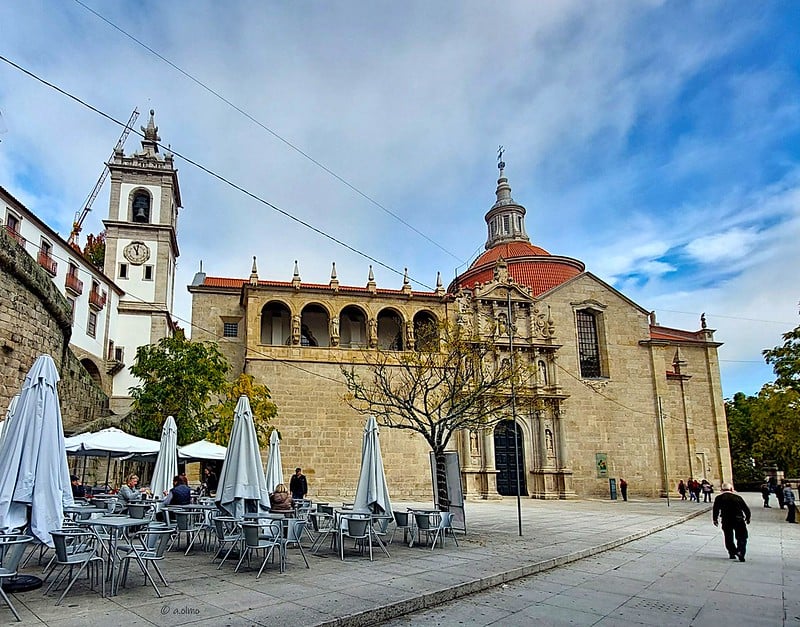
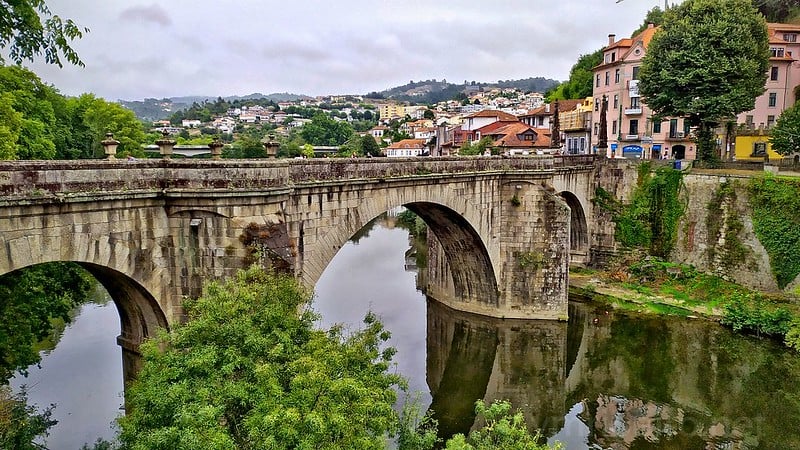
2. Relax at the Parque Florestal de Amarante
The Parque Florestal is a beautiful escape within the city and offers a verdant landscape ideal for relaxation and recreation. This park, with its well-maintained trails, is perfect for a leisurely walk, jog, or picnic. It has a peaceful ambiance and is a favorite spot for nature lovers and families. The playgrounds and open spaces are particularly popular among children.

3. Enjoy a wine tasting tour in the Vinho Verde region
Amarante lies in the heart of the Vinho Verde wine region known for its unique green wines. Visitors can try a number of wine tastings to explore local vineyards and learn about the wine-making process. These tours often include visits to historic wineries and often include a boat cruise in the world-famous Douro Valley.

4. Experience the thrill of water sports on the Tâmega River and cool off at Amarante Water Park
The Tâmega River, with its clear waters and natural beauty, is an ideal spot for water sports enthusiasts. Activities like kayaking, canoeing, and paddle boarding are popular here, offering a fun and adventurous way to explore the river’s surroundings. The river’s varying currents cater to both beginners and experienced adventurers, making it a great destination for a day of aquatic fun.
The Amarante Water Park is a 15-minute drive from the center of Amarante. You will find various types of water slides along with toboggans and swimming pools for adults and children.
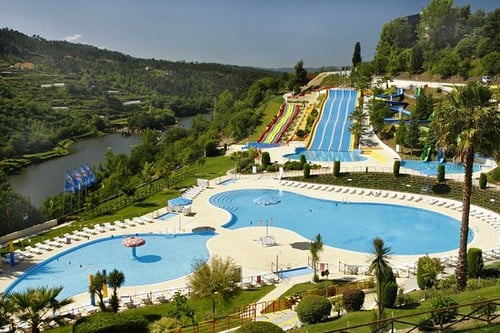
5. Discover the art of Amarante at the Amadeo de Souza-Cardoso Museum
Dedicated to the renowned Portuguese painter Amadeo de Souza-Cardoso, this museum showcases an impressive collection of his works, along with pieces by other contemporary artists.
Located in a historic building, the museum caters to lovers of both art and architecture. Its exhibitions provide insight into the modernist movement in Portugal and Amarante’s contribution to the arts. Please note that the museum is closed for lunch every day from 12:30 pm – 2 pm, with admission closing at 12:00 pm for the break.

Where to Eat in Amarante
Amarante offers a diverse and rich culinary landscape that reflects the town’s deep cultural heritage and its location in the fertile Douro region. Visitors to Amarante can indulge in various dining experiences, from traditional Portuguese cuisine, showcasing local specialties such as Vinho Verde and succulent meats, to more international offerings such as pizza.
The town’s charming riverside provides a gorgeous backdrop to its array of eateries, ranging from cozy, family-run taverns to upscale, gourmet restaurants. This variety ensures that Amarante caters to all tastes and preferences, making it a gastronomic destination worth exploring. Don’t miss its unique local conventual sweets and, if you dare, one of its phallic pastries.
Here are our 5 favorite restaurants in Amarante.
1. Casa Herédio
Casa Herédio stands out as a restaurant with one of Amarante’s most beautiful locations with fantastic views of the Tâmega River. The main courses here are not very big and are served tapas style.
Try the queijo no forno or the suckling pig sandwich. There are balcony seats facing either the church and the square or the river and both options really capture the feeling of the town while you are enjoying delicious food. Wash it all down with a glass of Vinho Verde, which this region is famous for. Lunch on the weekends can get crowded so please try to arrive early or book ahead.
Expect to spend around €50 for a meal for two, but the exceptional location and service justify the price.
2. Taberna do Coelho
Taberna do Coelho is a quick 7-minute drive from the center of Amarante and the standout dish here by far is the cabrito assado no forno (oven-roasted goat). Feijoada is another favorite, which is a stew of beans with beef and pork.
Dishes are served in traditional clay cookware and meat is usually roasted along with potatoes, a Portuguese classic. Keep in mind that Taberna do Coelho is only open Friday, Saturday, and to Sunday until lunchtime so plan accordingly if you’d like to visit this charming restaurant. A meal for two here averages about €60.
3. Pobre Telo
Despite the name, this restaurant offers a rich dining experience with easy parking nearby and another gorgeous location where the elegant and the rustic merge. You will feel like royalty when you walk through these doors and your stomach will feel the same as you treat it to traditional Portuguese served with flair.
Try the octopus, cod, and veal steak. Be sure to finish off your meal with traditional sweets from Amarante (see the next two places on our list). Service can sometimes be a little slow, but relaxing in this sumptuous environment makes up for the wait. Prices are higher (around €75 for two), but the culinary experience is unparalleled.
4. Confeitaria da Ponte
Confeitaria da Ponte, near the iconic São Gonçalo Bridge, is the perfect spot for a casual meal or a refreshing drink. Known for its friendly atmosphere, it serves a wide range of snacks, sandwiches, pastries, and excellent coffee. It’s a great place to relax and enjoy the scenic view of the Tâmega River. Take the opportunity here to try local sweets such as the Papos de Anjo (translated as “angel’s double-chin), a traditional Portuguese conventual sweet made from whipped egg yolks, baked, and then boiled in sugar syrup.
You can also find Lérias, small sweets made from egg yolks, almonds, and sugar. Finally, look for the Brisas do Tâmega, stuffed with almond kernels and egg jam. So much goodness in one charming place. Depending on how many sweets you go for, you may end up spending as much as €10 per person if you also add in a coffee.

5. Doçaria Mário
Sweets, sweets, and more sweets. If Confeitaria da Ponte isn’t enough for you, make another sugar stop at Doçaria Mario. With lovely wooden interiors and an incredible view of the river including a generous terrace, time slows down to the pace of the river here and you may find yourself ordering a second coffee as you forget about the busy life in Portugal’s larger cities.
The previously mentioned Confeitaria da Ponte is a common stop for tour groups coming through the area so you may want to come here to avoid the crowds. Prices here are a bit high and you can expect to pay about €10 per person here with coffee, but you may find that it’s worth it for the exquisite location.
Getting around in Amarante
If you are staying near Porto in northern Portugal, then you can book this tour to the Douro Valley that stops in Amarante on the way for €89.10. This tour gives you a more premium small group option that includes visits to two prestigious wine estates paired with a 3-course lunch starting at €130. There is also another tour of Amarante itself exploring the art and gastronomy for €75.
Final Thoughts
If you would like to check out some other towns nearby, visit Porto, Braga, or Guimarāes.
⬇️Please share your favorite activities and things to do in Amarante in the comments below ⬇️

